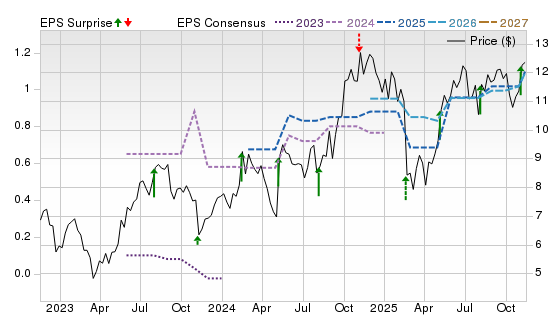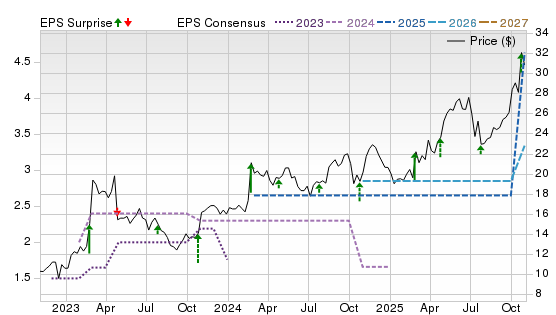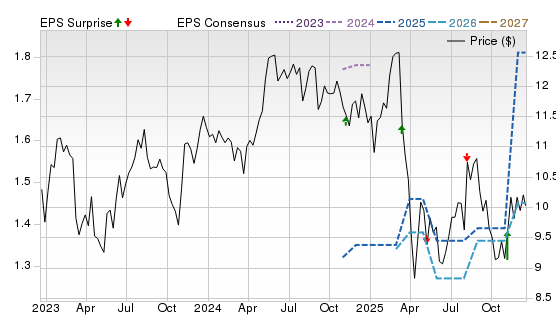5 Best Small-Cap Stocks to Buy Today
| Company (Ticker) | 12 Week Price Change | Forward PE | Price | Proj EPS Growth (1 Year) | Projected Sales Growth (1Y) |
|---|---|---|---|---|---|
| LendingTree (TREE) | -26.65% | 10.59 | $52.55 | 50.05% | 20.48% |
| Fiverr International (FVRR) | -20.44% | 6.87 | $19.90 | 21.85% | 10.47% |
| Great Lakes Dredge & Dock (GLDD) | 10.02% | 12.16 | $13.46 | 30.06% | 11.61% |
| Universal Insurance Holdings (UVE) | 30.94% | 7.13 | $33.62 | 158.66% | 3.19% |
| CION Investment Corporation (CION) | 3.51% | 5.54 | $9.92 | 1.12% | -4.19% |
*Updated on December 18, 2025.
LendingTree (TREE)
$52.55 USD +1.86 (3.67%)
3-Year Stock Price Performance

Premium Research for TREE
- Zacks Rank
- Strong Buy 1
- Style Scores
A Value A Growth C Momentum A VGM
- Market Cap:$692.97 M
- Projected EPS Growth:50.16%
- Last Quarter EPS Growth:74.03%
- Last EPS Surprise:38.21%
- Next EPS Report date:March 4, 2026
Our Take:
LendingTree runs a leading online marketplace for consumer credit, insurance and small business finance. It has a market capitalization of roughly $693 million. A Zacks Rank #1 (Strong Buy) with Style Scores of A for Value and Growth highlights broad positive estimate revisions paired with attractive valuation, while C for Momentum reflects a stock still consolidating after a strong rebound.
The latest quarter showed double-digit growth across segments, led by Insurance and steady Consumer trends, with adjusted EBITDA rising as marketing efficiency improves. Strategically, TREE has pruned lower-return activities and is leaning into variable-marketing margin discipline and membership-driven engagement, which should support margins as rate headwinds ease.
On the Price, Consensus & EPS Surprise chart, consensus for 2026–27 inflects sharply higher and the price has started to recover alongside recent upside surprises. The setup suggests that estimate momentum remains the near-term catalyst.
Fiverr International (FVRR)
$19.90 USD -0.03 (-0.15%)
3-Year Stock Price Performance

Premium Research for FVRR
- Zacks Rank
- Strong Buy 1
- Style Scores
C Value C Growth C Momentum B VGM
- Market Cap:$714.37 M
- Projected EPS Growth:21.85%
- Last Quarter EPS Growth:32.35%
- Last EPS Surprise:10.00%
- Next EPS Report date:Feb. 18, 2026
Our Take:
Fiverr operates a global marketplace for freelance services. It has a market cap of $714.4 million. A Zacks Rank #1, despite Style Scores of C for Value, Growth and Momentum, reflects estimate support driven by disciplined execution. In the last reported quarter, revenue grew 8.3% to $107.9 million, and the adjusted EBITDA margin reached 22.4%, driven by upmarket initiatives, AI-related categories, and a richer mix of value-added services.
While active buyers fell in the first three quarters of 2025, spend per buyer increased by nearly 12%, signposting healthier unit economics. Its focus on profitability, cash generation and product expansion adds resilience while marketplace volumes normalize.
On the chart, consensus lines for 2025–27 drift higher as price trends sideways and surprises skew positive. That mismatch suits a setup where improving estimates and higher ticket-sized purchases can be the spark for better momentum over time.
Great Lakes Dredge & Dock (GLDD)
$13.46 USD +0.18 (1.36%)
3-Year Stock Price Performance

Premium Research for GLDD
- Zacks Rank
- Strong Buy 1
- Style Scores
A Value A Growth F Momentum A VGM
- Market Cap:$903.03 M
- Projected EPS Growth:29.76%
- Last Quarter EPS Growth:85.71%
- Last EPS Surprise:52.94%
- Next EPS Report date:Feb. 17, 2026
Our Take:
Great Lakes Dredge & Dock is the largest U.S. dredging contractor serving coastal protection and port deepening. Its market cap is around $903 million. A Zacks Rank #1 with Style Scores of A for Value and Growth underscores estimate revisions and improving mix, while F for Momentum reflects uneven trading.
The last reported quarter delivered contract revenue growth, higher profitability and a $1 billion backlog, supported by capital and coastal-protection work and LNG-related projects. Backlog visibility and a modernizing fleet provide a multi-year runway as climate resiliency and channel maintenance spending persist, even as bid timing can make results lumpy quarter to quarter.
The chart shows 2025–27 consensus estimates stepping higher as the stock rebounds from last year’s lows, with recent earnings beats tracking the recovery. Meanwhile, the new hopper dredge, Amelia Island, joined the fleet in August and was deployed immediately, highlighting strong demand.
Universal Insurance Holdings (UVE)
$33.62 USD +0.61 (1.85%)
3-Year Stock Price Performance

Premium Research for UVE
- Zacks Rank
- Strong Buy 1
- Style Scores
A Value A Growth D Momentum A VGM
- Market Cap:$925.89 M
- Projected EPS Growth:158.66%
- Last Quarter EPS Growth:10.57%
- Last EPS Surprise:23.64%
- Next EPS Report date:Feb. 24, 2025
Our Take:
Universal Insurance writes homeowners’ insurance and provides related services, primarily in Florida. It has a market cap of roughly $925.9 million. A Zacks Rank #1 with Style Scores of A for Value and Growth and D for Momentum reflects estimate strength after a profitable hurricane season. Improved loss ratio, modest premium growth and tight expense control are major tailwinds.
Its adjusted book value per share rose nearly 19% YoY in the last reported quarter, while capital returns continued via buybacks and dividends. Management emphasized conservative reserving and a sturdier Florida market backdrop into 2026, positioning UVE to balance pricing, reinsurance and growth.
Its organic business model continues to enable it to generate deep double-digit return on equity, while growing fixed income reinvestment yields support net investment income. On the chart, estimates for 2026–27 trend higher as the stock grinds up with mostly positive surprises.
CION Investment Corporation (CION)
$9.92 USD -0.10 (-1.00%)
3-Year Stock Price Performance

Premium Research for CION
- Zacks Rank
- Strong Buy 1
- Style Scores
A Value A Growth D Momentum A VGM
- Market Cap:$521.91 M
- Projected EPS Growth:1.12%
- Last Quarter EPS Growth:131.25%
- Last EPS Surprise:111.43%
- Next EPS Report date:March 12, 2026
Our Take:
CION Investment is a middle-market lender structured as a business development company. It has a market cap of $521.9 million. A Zacks Rank #1 with Style Scores of A for Value and Growth and D for Momentum reflects estimate revisions following a strong quarter, with modest momentum.
Higher transaction activities are aiding its earnings. In the last reported quarter, net investment income reached 74 cents per share, covering the 36 cents base distribution over 2X, with NAV up sequentially. In 2026, it is moving from quarterly to monthly distributions. As of Sept. 30, 2025, it had around $1.9 billion in total assets. It had investments in 91 portfolio companies in 23 industries.
On the chart, consensus revisions for 2026 climb as price breaks out from a long base, mirroring recent beats. Its focus on high-quality senior secured debt financings, primarily first lien, will support durability.
Methodology
The Zacks Rank is a proprietary stock-rating model that uses trends in earnings estimate revisions and earnings-per-share (EPS) surprises to classify stocks into five groups: #1 (Strong Buy), #2 (Buy), #3 (Hold), #4 (Sell) and #5 (Strong Sell). The Zacks Rank is calculated through four primary factors related to earnings estimates: analysts' consensus on earnings estimate revisions, the magnitude of revision change, the upside potential and estimate surprise (or the degree in which earnings per share deviated from the previous quarter).
Zacks builds the data from 3,000 analysts at over 150 different brokerage firms. The average yearly gain for Zacks Rank #1 (Strong Buy) stocks is +23.62% per year from January, 1988, through June 2, 2025.
For this list, only companies trading 100,000 shares or more daily and in the top 50% of industries were considered. All stocks had a Zacks Rank #1 rank at the time of selection. All information is current as of market open, Dec. 18, 2025.
Guide to Best Small-Cap Stocks
What Are Small-Cap Stocks?
“Small-cap” refers to publicly traded companies whose market capitalisation falls below a certain threshold. The exact cutoff varies by region or index provider, but commonly in the U.S. small-caps are defined as roughly $300 million to $2 billion in market cap.
Why Invest in Small-Cap Stocks
- Growth potential: Because these companies are smaller, they have more runway to grow revenues, profits and market share.
- Diversification: They often behave differently than large-cap stocks, so including them can enhance portfolio diversification.
- Value opportunity: Many small-caps are currently trading at valuations below historical norms or relative to large caps — offering potential mispricing opportunities.
Small-Cap vs Mid-Cap vs Large-Cap Stocks
Small Cap:
- Market capitalization of between $300 million to $2 billion (but designation can vary among indices).
- Higher growth potential, but higher risk and less liquidity.
- More volatile and more sensitive to economic and interest rate shifts.
Medium (Mid) Cap:
- Market capitalization generally from $2 billion to $10 billion.
- Balanced between growth and stability.
- Fewer extremes than small caps, but possibly less upside.
Large Cap:
- Market cap is usually over $10 billion.
- Established companies, lower growth but more stability.
Benefits of Investing in Small-Cap Stocks
- Potential for outsized returns if a small company scales successfully.
- Greater market inefficiencies — less analyst coverage means more opportunity for undervalued gems.
- Cyclical upside — when conditions improve (such as lower rates or economic recovery) small caps often lead the trend.
Risks and Challenges of Small-Cap Stocks
- Higher volatility — More price swings, less predictable earnings.
- Sensitivity to economic and interest rate cycles — Small cap companies often carry more floating rate debt, shorter maturities, and weaker financials. Small cap stocks are generally “more vulnerable” in elevated-interest rate environments.
- Less liquidity and coverage — Small cap stocks may be harder to trade, with fewer analysts covering them and less public information
- Greater capital risk — Many small-cap firms are still unprofitable; their future may be less certain.
Small-Cap ETFs vs Small-Cap Stocks
- ETFs: Small-cap exchange traded funds provide instant diversification, lower company-specific risk, simpler to invest.
- Individual stocks: Offer higher potential upside (and higher risk). You can benefit from picking a breakout company, but the odds of mis-steps are higher.
- If you believe in the asset class broadly, a small-cap ETF may be a smarter choice; if you want to hand-pick potential winners and accept higher risk, then individual stocks might appeal.
How to Choose the Best Small-Cap Stocks
Look at factors like:
- Business quality: Profitability (or path to profitability), return on invested capital, competitive advantage (often known as a ‘moat”).
- Financial strength: Manageable debt, good cash flow and reasonable valuation.
- Valuation: Since small caps are currently trading at depressed valuations relative to large caps, finding ones that are both good quality and cheap may give you an edge.
- Sector and cycle fit: Because many small-caps are more cyclical, consider how economic or rate trends might affect them.
- Liquidity and transparency: Ensure the company has sufficient trading volume and good public disclosure.
- Time horizon: Small-cap investing often requires patience — these stocks may take time to execute and get recognised by the market.
How to Invest in Small-Cap Stocks
- Decide your allocation: How much of your portfolio are you willing to place into higher-risk small caps?
- Combined approach: Consider holding a small-cap ETF and a few hand-picked individual names for upside.
- Use dollar-cost averaging to smooth entry over time (given the greater volatility of small cap stocks.)
- Monitor macroeconomic variables: Interest rates, economic growth, inflation, liquidity — these matter for small caps.
- Stay disciplined: Set stop-losses or position limits; avoid over-allocating to speculative names
- Review your time horizon: Small caps typically work better when held for multiple years rather than trading in and out.
Tips for Building a Small-Cap Portfolio
- Diversify across sectors to avoid concentration risk (such as spreading across small-cap healthcare, industrial, consumer stocks and so forth).
- Blend quality and speculative: Have some “core” small-cap holdings with proven businesses plus some high-upside speculative names.
- Watch weighting: Don’t let any one small-cap issue become too big a part of your portfolio.
- Track valuations: Since small-cap valuations can re-rate, be ready to adjust when valuations seem stretched.
- Stay updated on macro shifts: For example, rate cuts can help small-caps more than large caps. Medium term, that dynamic could drive performance.
Frequently Asked Questions About Small-Cap Stocks
How long should I hold small-cap stocks?
Because of their risk and growth nature,a time horizon of 3-5 years or more is generally preferable. Short-term trading can be risky due to volatility and structural shifts.
Are small-cap stocks suitable for beginners?
They can be, but only if the investor understands the risks, is comfortable with volatility and uses appropriate position sizing. Beginners might start with ETFs or limit exposure rather than going heavy into speculative names.
What sectors do the best small-cap stocks usually come from?
Historically: industrials, consumer discretionary, healthcare/biotech, technology. Small caps tend to have more cyclical exposure compared to large caps.
Also note many small-caps fly under the radar.
Can small-cap stocks be dividend-paying?
Yes — though less commonly than large-caps. Many small-cap companies reinvest profits into growth rather than returning dividends. But some mature small-caps may pay dividends.
What is the historical performance of small-cap stocks?
- Historically small-caps offered a “small-cap premium” over large-caps due to greater growth potential.
- However, more recently this premium has eroded — for example, J.P. Morgan reports that the small-cap growth engine has diminished in recent years.
- Still, some data suggests that when macro conditions shift (such as interest rate cuts and economic recovery), small caps tend to outperform large caps.















